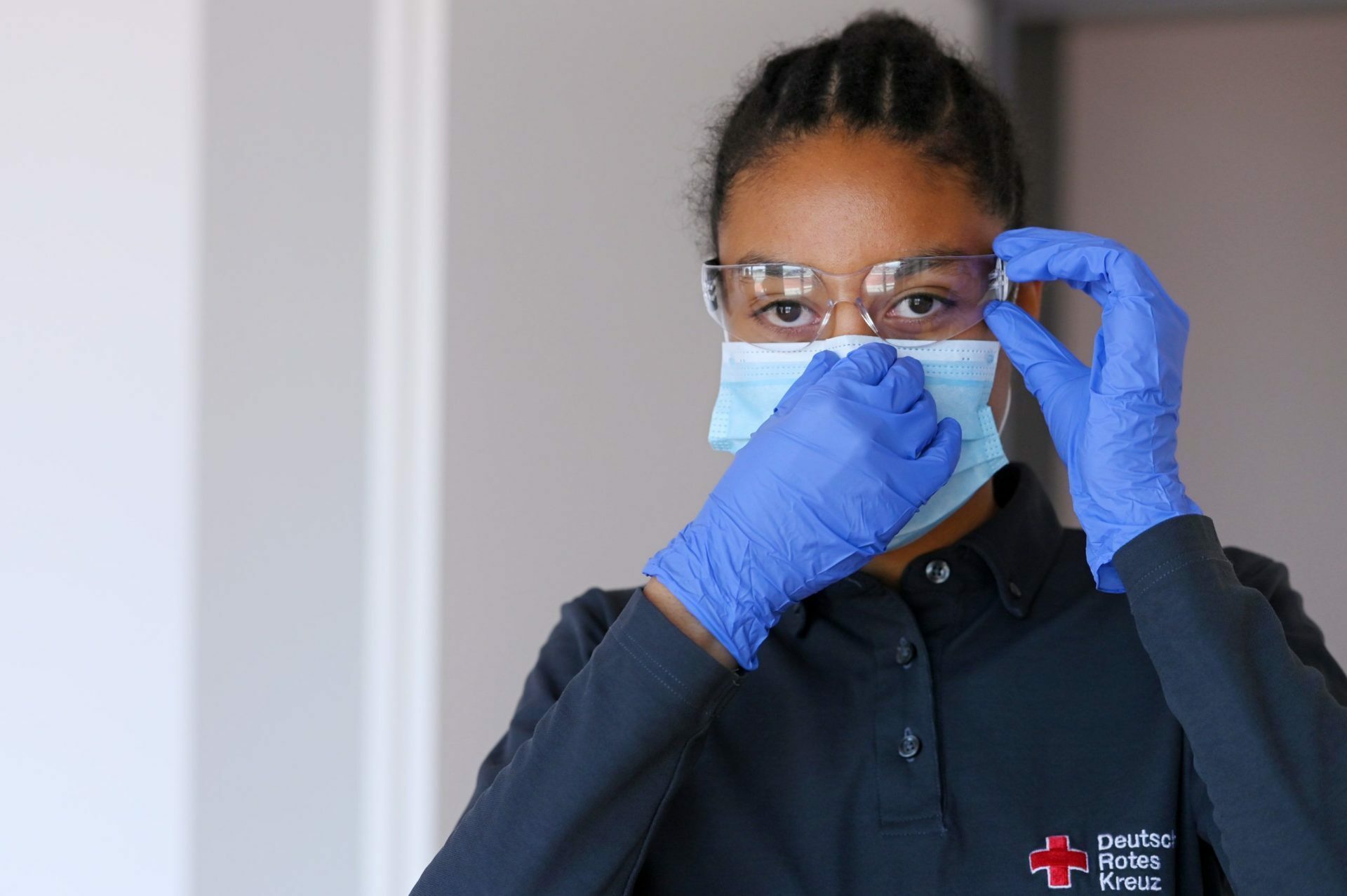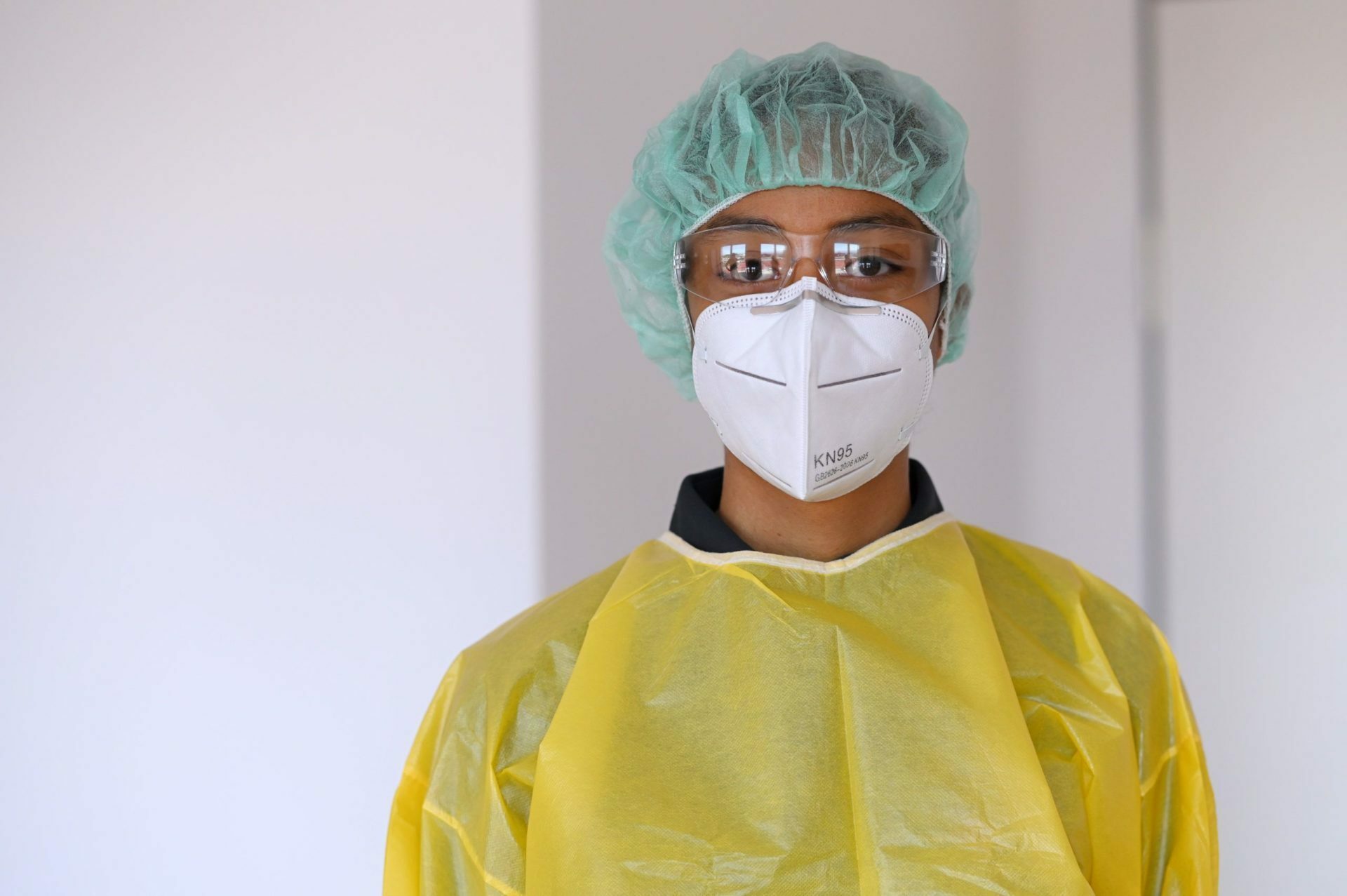“Call me when you are there. There is no one from the local Red Cross club at the moment, so the door will be closed”, Reinhard Breh ends the telephone call settling the appointment at the Friedrichshafen rescue station of the German Red Cross (DRK). There is currently a state of emergency here because of the corona virus. The parking lot of the local association is accordingly unusually empty. Breh greets friendly when he opens the door, points – keeping his distance – into the staircase: “We are at the top.”
The challenge: Keeping the threat in mind
Having arrived in his office, he quickly clears his desk space, puts two chairs between the training manikin with protective clothing on and the door: “This way we can keep our distance.” Stefan Martin, the deputy hygiene coordinator, comes in almost giving a handshake, quickly putting his hand back to his pocket, smiles and says: “We aren’t supposed to do so.” That being said, the conversation is already in the middle of the topic these days: hygiene measures, infection protection against the circulating coronavirus. “It is difficult to keep the virus in mind,” comments Breh. They also noticed that in themselves. You have to keep reminding yourself that there is a danger, even if you can’t see it. “We are laymen against all these great virologists,” says Breh, “but what we know so far, it is highly contagious and particularly dangerous because you can be infected without knowing it.”
It is difficult to keep the exceptional situation in mind, especially now that it looks as if the danger has already passed and especially in the Lake Constance district with a total of just 290 (positive tested) infected. “Even if you naturally have to assume a high number of unreported cases,” Martin adds.

In the ambulance, the crew currently usually wears a simple surgical mask, simple safety glasses and a pair of gloves. If Covid is suspected, the protective level is “increased”. The paramedics do not wear highly protective clothing prophylactically as every minute counts in case of an emergency.
“We also had one or the other in quarantine,” explains Breh, because there was contact without protective clothing to someone who later tested positive for SARS-CoV-2 in the hospital. “This quarter of an hour, sometimes just ten minutes too close to the patient, could be prevented,” he emphasizes. He had tried to train all paramedics to change their usual routine. “I always say: Actually, the clinical thermometer no longer has to be in your backpack, but in your pocket,” he explains, “and then you put it in the patient’s ear first.” Fever is an indication that a Covid-19 Disease may be present. “If I find out, I can protect myself and take a step back,” he explains. This initial inspection, i.e. temperature measurement, costs less than 15 seconds and saves two weeks of downtime due to quarantine in the worst case scenario.
Depending on the qualification, this could become a problem: “In the emergency medic area, it gets tight when five are not available.”
We only had half a week in which we were a bit thin with the protective clothing in one area or another.

You can tell that people have become more tolerant of the masks since you can see them everywhere in the media coverage: We had two suspected Covid patients who really ejected phlegm. So I’m glad when that goes into the mask, which I can change three or four times on the way. You know that this is transmitted via droplets. It is better to cough into the mask. I don’t have to have this everywhere in the car, even if it is of course disinfected afterwards.
Even protective clothing, which was scarce throughout Germany, was sufficiently available: “We only had half a week in which we were a bit thin with the protective clothing in one area or another.” Stefan Martin and he had already at the beginning of January namely adjusted to the upcoming exceptional situation. “Everyone still thought: China is far away,” Martin recalls. With a shrug, he adds, it is now relative with the “far away”: “Planes make it possible.” As a first step, they had increased storage capacity in January, bought more protective clothing and stored it, made “everything safe”, then manuals and Recommendations for employees compiled. “I still remember that we had a quality management audit in mid-January,” recalls Breh, laughing, “and our auditor was very surprised that everything was already in place.” Ultimately, they are now glad that they have everything ready so early even if Breh notes: “In retrospect, I would say we should have increased the storage capacity again. But nobody could have guessed that.”
Because protective clothing plays a special role these days, Breh and Martin explain the additional challenge this poses. In particular, taking off the protective clothing needs to be learned so that the paramedics do not come into contact with the contaminated surfaces of the protective clothing when undressing. While Martin and Breh explain, DRK Lucy Hartle shows what the correct handling looks like. This is how this little explanatory video was created:



